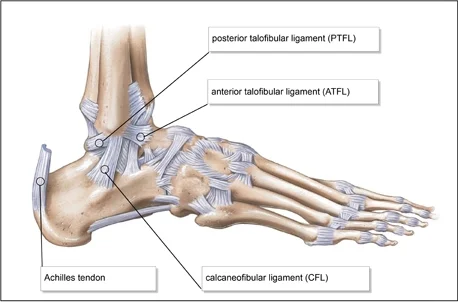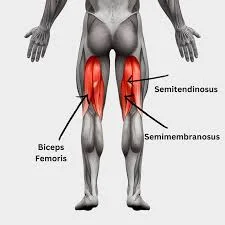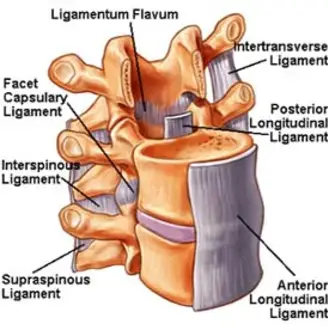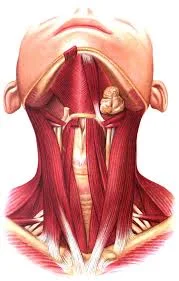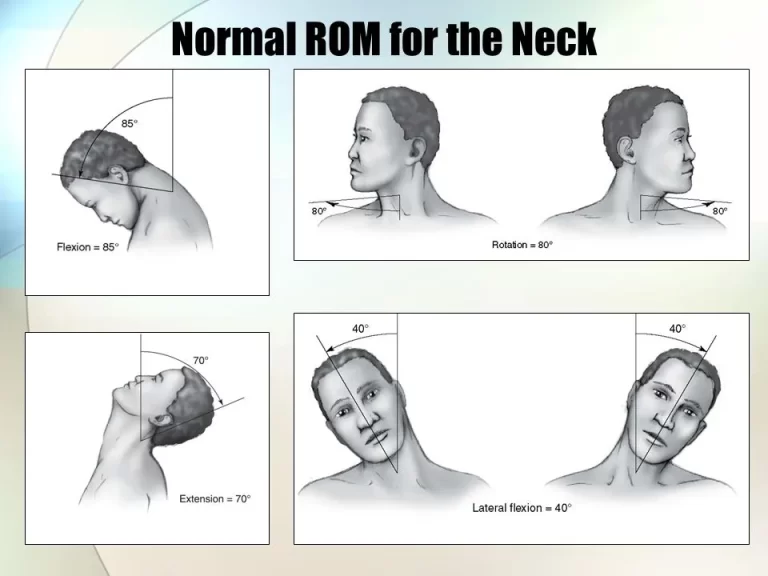Posterior Talofibular Ligament
Introduction
The Posterior Talofibular Ligament (PTFL) is a strong ligament in the ankle that connects the talus to the fibula. It is the strongest of the lateral ankle ligaments and plays a crucial role in stabilizing the ankle, especially in preventing excessive posterior movement of the talus. Injuries to the PTFL are rare and usually occur in severe ankle sprains or dislocations.
Ankle sprains frequently cause injury to the posterior talofibular ligament, which helps prevent unnecessary inward rotation and inversion of the ankle. Knowing the structure and function of this ligament is critical for diagnosing and treating ankle injuries.
Structure of the Posterior Talofibular Ligament
The talus bone of the foot and the fibula bone of the leg are joined by the posterior talofibular ligament (PTFL), a robust, fibrous band. Together with the calcaneofibular ligament (CFL) and the anterior talofibular ligament (ATFL), it is one of the three main ligaments that comprise the lateral ankle complex.
The posterior talofibular ligament originates from the lateral malleolus of the posterior side of the fibula and connects to the lateral tubercle of the talus bone. It forms an angle with a horizontal plane of about 45 degrees as it runs obliquely backward and downward.
Dense collagen fibers arranged parallel to one another form up the posterior talofibular ligament. It gives the ankle joint more stability because it is thicker and stronger than the ATFL and CFL.
Thus, in general, the posterior talofibular ligament is a crucial component that supports the ankle joint’s stability and functionality. It can help prevent ankle sprains and other injuries because of its location and orientation, which make it especially effective at resisting unnecessary inversion forces.
Attachment of the Posterior Talofibular Ligament
The posterior aspect of the lateral malleolus of the fibula, a bony protrusion on the outside of the ankle, is where the posterior talofibular ligament (PTFL) begins. It originates specifically from the groove that runs between the posterior border of the fibula and the lateral malleolus.
From there, the posterior talofibular ligament travels backward and downward at an angle to the foot’s talus bone. It attaches to the talus’s lateral tubercle, a tiny bony protuberance on the talus’s lateral side.
The calcaneofibular ligament (CFL) and anterior talofibular ligament (ATFL), the other two main ligaments of the lateral ankle complex, have their insertion points directly behind and beneath the posterior talofibular ligament. The ankle joint is stabilized by the triangular shape formed by these three ligaments.
The angle at which the posterior talofibular ligament is oriented concerning the horizontal plane is roughly 45 degrees. Ankle injuries frequently occur as a result of unnecessary inversion or outward rolling of the foot, which this orientation enables it to withstand.
Therefore, the posterior talofibular ligament’s attachments are essential to its ability to stabilize the ankle joint and protect against injury. Its strong connection, which can sustain considerable forces during weight-bearing activities, is created by its insertion on the talus and origin on the fibula.
Functions of the Posterior Talofibular Ligament
Ankle joint stabilization and limiting unnecessary movement that may cause injury are vital functions of the posterior talofibular ligament (PTFL). The posterior talofibular ligament serves the following primary purposes:
Prevents inversion: The distance between the posterior talofibular ligament and the horizontal plane is about 45 degrees. It can withstand excessive inversion or outward rolling of the foot, which is a common mechanism of ankle injuries, thanks to this orientation. The posterior talofibular ligament tightens when the foot is forced into an inverted position, assisting in limiting unnecessary ankle joint movement.
Restricts plantar flexion: The ankle joint’s plantar flexion is likewise restricted by the posterior talofibular ligament. The motion that occurs when the foot is pointed downward, as when you stand on your tiptoes, is called plantar flexion. Ankle injuries can also result from unnecessary plantar flexion, which is prevented by the posterior talofibular ligament.
Stability: The ankle joint is stabilized by the posterior talofibular ligament, which forms a triangle with the calcaneofibular ligament (CFL) and anterior talofibular ligament (ATFL). Together, these three ligaments limit unnecessary movement in all directions, maintaining proper alignment and lowering the risk of injury.
Supports weight-bearing activities: The posterior talofibular ligament’s attachments are essential for maintaining the ankle joint’s stability during weight-bearing exercises like running, jumping, and walking. Effective force transfer through the ankle joint is made possible by the posterior talofibular ligament’s strong connection between the fibula and talus, helping in proper balance and avoiding injury.
All things considered, the lateral ankle complex includes the posterior talofibular ligament, which is vital for maintaining ankle joint stability and avoiding injury when bearing weight.
Blood supply of the Posterior Talofibular Ligament
The branches of the peroneal and posterior tibial arteries supply blood to the posterior talofibular ligament (PTFL). The ligament receives the nutrition and oxygen it needs from these arteries to preserve its structural soundness and functionality.
The popliteal artery‘s principal branch, the posterior tibial artery, travels behind the tibia bone down the leg. The fibular artery, which provides blood to the lateral aspect of the leg and ankle joint, is one of its many branches. The posterior talofibular ligament and other lateral ankle ligaments receive blood from the peroneal artery, which originates from the fibular artery.
The talus bone and the surrounding ligaments, including the posterior talofibular ligament, receive blood from the lateral tarsal artery, a branch of the peroneal artery. The posterior talofibular ligament receives an additional blood supply from the lateral tarsal artery, which runs along the lateral side of the foot and ankle.
For the posterior talofibular ligament to remain strong and avoid injury, its blood supply is crucial. The ligament may weaken and become more vulnerable to injury during weight-bearing activities if there is insufficient blood flow. For the best ankle function and injury prevention, the posterior talofibular ligament’s blood supply must be kept healthy.
Injuries of the Posterior Talofibular Ligament
Activities that require sudden or excessive twisting or rolling of the ankle can cause injuries to the posterior talofibular ligament (PTFL). The following are some typical activities that can result in injuries to the posterior talofibular ligament:
Sports: Playing sports that require agility, cutting, jumping, and pivoting can strain the ankle joint and its ligaments, particularly the posterior talofibular ligament. High-risk sports for posterior talofibular ligament injuries include basketball, soccer, football, tennis, and volleyball.
Uneven surfaces: Walking or running on uneven terrain, like rocky terrain or a bumpy road, can cause ankle twists and turns and injure the posterior talofibular ligament.
High heels: Wearing shoes with high heels may affect the ankle’s and foot’s natural alignment, which puts additional strain on the ligaments. Injuries to the posterior talofibular ligament may result from this, particularly if the heels are worn for prolonged periods.
Falls: Ankles can twist or bend abnormally when falling from a height or tripping over an obstruction, which can result in injuries to the posterior talofibular ligament.
Overuse: Over time, the posterior talofibular ligament may sustain overuse injuries from repeatedly engaging in ankle-moving activities like walking or long-distance running.
Inadequate warm-up: By decreasing the ligaments’ strength and flexibility, improper warm-up prior to exercise or sports participation can raise the risk of PTFL injuries.
The posterior talofibular ligament can sustain anything from minor sprains to total tears. Ankle pain, swelling, bruising, stiffness, and trouble bearing weight are all signs of a posterior talofibular ligament injury. Injuries to the posterior talofibular ligament are usually treated with physical therapy, rest, ice, compression, and elevation (RICE), and in severe situations, surgery.
Symptoms of the PTFL Injury
The ligament that joins the talus and fibula bones on the outside of the ankle joint is called the posterior talofibular ligament (PTFL). A variety of symptoms may arise from injury to this ligament, including:
Pain: One common sign of a posterior talofibular ligament injury is pain. It could be dull or sharp, and it could hurt on the outside of the ankle.
Swelling: Another typical sign of a posterior talofibular ligament injury is swelling. The ankle may become tender to the touch and swollen.
Bruising: As a result of the injury, bruising may develop around the ankle joint.
Stiffness: The ankle joint may become stiff, which makes it difficult to move the ankle.
Weight-bearing difficulty: The pain and swelling in the affected ankle may make it difficult to bear weight on it.
Ankle instability resulting from a posterior talofibular ligament injury can make it difficult to walk or engage in activities requiring balance.
Clicking or popping: When moving the foot, there may occasionally be a clicking or popping sound in the ankle joint.
If any of these symptoms are present, you must seek medical attention because if left untreated, posterior talofibular ligament injuries can result in chronic ankle instability and other complications.
Diagnosis of the PTFL Injury
A medical professional’s physical examination is usually required to diagnose a posterior talofibular ligament injury. The medical professional will check for pain, swelling, bruises, and instability in the ankle during the examination. To check for a range of motion and any popping or clicking sounds, they might also move the ankle joint.
Imaging tests may also be used to confirm the diagnosis and assess the severity of the injury. While an MRI can offer a more thorough view of soft tissue injuries like ligament tears, X-rays can assist in determining any fractures or dislocations.
Ankle stability may occasionally be evaluated using a stress test. While the patient is standing or walking, pressure is applied to the ankle joint to check for unnecessary movement or instability.
The patient should be informed of their treatment options after a diagnosis has been made. These could include physical therapy, bracing or taping, rest, ice, compression, and elevation (RICE), and in severe situations, surgery.
The posterior drawer test
A physical examination technique called the posterior drawer test is used to evaluate the stability of the ankle joint, more especially the posterior talofibular ligament (PTFL). Usually, a medical professional performs this test as part of an ankle physical examination.
The patient usually sits or lies down with their foot flat on the exam table and their knee bent to perform the posterior drawer test. The medical professional will then place one hand on the front of the ankle, just above the ankle joint, while the other will grasp the heel of the affected foot.
The medical professional will then try to move the heel backward in relation to the lower leg by gently pressing on the back of the heel. An injury to the posterior talofibular ligament may be shown if the ankle joint is unstable or moves excessively.
Along with evaluating the patient’s range of motion and pain levels, the healthcare professional will also check for any clicking or popping sounds during the test. X-rays or an MRI are examples of additional imaging tests that may be required to confirm the diagnosis and determine the extent of injury, depending on how severe the injury is.
Therefore, the posterior drawer test is generally a straightforward and non-invasive method of evaluating ankle stability and identifying injuries to the posterior talofibular ligament. For ankle injuries, it is usually done as a component of a thorough physical examination.
Treatment of the Posterior talofibular Ligament Injury
Conservative treatment
The ligament known as the Posterior Talofibular Ligament (PTFL) joins the lower leg’s fibula bone to the foot’s talus bone. It is in the role of keeping the ankle joint stable and limiting the foot’s excessive outward rotation. Before considering surgical options, conservative treatment may be advised when this ligament is injured.
RICE, or rest, ice, compression, and elevation, is the most common conservative treatment for the posterior talofibular ligament. This helps to lessen the injured area’s pain, swelling, and inflammation. Pain and inflammation can also be further reduced by giving non-steroidal anti-inflammatory drugs (NSAIDs).
Another important aspect of conservative treatment for injuries to the posterior talofibular ligament is physical therapy. Patients who want to increase their ankle joint’s range of motion and stability can benefit from stretching and strengthening exercises provided by a physical therapist. This could involve exercises like calf raises, ankle circles, and balance training.
To immobilize the ankle and promote ligament healing, a brace or cast may be advised in certain situations. For patients who are at risk of re-injury or for more serious injuries, this might be required.
The general goals of conservative treatment for injuries to the posterior talofibular ligament are to lessen discomfort and inflammation, increase ankle joint stability and range of motion, and encourage ligament healing. Many patients can recover completely without surgery if they receive the right treatment and rehabilitation.
Physiotherapy treatment
Stretching and strengthening exercises are commonly used in physiotherapy to treat the posterior talofibular ligament, along with other techniques like manual therapy and electrical stimulation.
Stretching exercises are essential for increasing ankle joint range of motion and decreasing stiffness. To help stretch the muscles and ligaments surrounding the ankle, a physical therapist might recommend exercises like heel drops, calf stretches, and ankle circles.
Additionally, strengthening exercises are essential for enhancing ankle joint stability and avoiding re-injury. To help strengthen the muscles surrounding the ankle, a physical therapist might recommend exercises like ankle dorsiflexion, toe raises, and calf raises.
Joint mobilization and massage are examples of manual therapy techniques that can be used to help lessen pain and inflammation in the affected area. This may facilitate the healing of the injured ligament and increase circulation.
To lessen pain and encourage healing, electrical stimulation may also be utilized. This can lessen pain and increase circulation by stimulating the muscles and tissues surrounding the ankle with a tiny electrical current.
The overall goals of physiotherapy treatment for injuries to the posterior talofibular ligament are to lessen pain and inflammation, increase ankle joint stability and range of motion, and encourage the ligament’s healing process. Many patients can recover completely without surgery if they receive the right treatment and rehabilitation.
Risk factors
The possibility of suffering a posterior talofibular ligament injury can be raised by several risk factors. These consist of:
Ankle sprains: Ankle ligaments can become weaker and more prone to injury after a prior sprain.
Participation in sports: Jumping, pivoting, and sudden direction changes are common in sports like football, basketball, and soccer, which raises the risk of ankle injuries.
Overuse: Overuse injuries, such as posterior talofibular ligament injuries, can result from repetitive strain on the ankle joint, such as that caused by running or jumping.
Anatomical abnormalities: Some anatomical characteristics, like flat feet or high arches, may affect how the foot and ankle move, which raises the risk of injury.
Bad footwear: The risk of injury can be increased by wearing shoes that don’t give the ankle enough support or stability.
Age: Because the ligaments and tendons in the ankle can weaken and lose their flexibility with age, older people are more likely to sustain posterior talofibular ligament injuries.
Obesity: Carrying too much weight can strain the ankle joint and raise the risk of injury.
Poor conditioning: The risk of injury during physical activity can be increased by weak muscles and limited ankle and lower leg flexibility.
Thus, people with anatomical abnormalities, poor conditioning, and those who play sports or engage in activities that put repetitive strain on the ankle joint may be more susceptible to a posterior talofibular ligament injury.
How can posterior talofibular ligament injuries be avoided?
A variety of techniques can help strengthen the ankle joint, increase flexibility, and lower the risk of overuse and traumatic injuries to prevent posterior talofibular ligament injuries. The following advice can help you avoid injuries to the posterior talofibular ligament:
Put on appropriate footwear: Select shoes that provide your ankles and feet with the right quantity of stability and support. Seek out footwear with a supportive arch, a cushioned sole, and a firm heel counter.
Warm-up and stretch: Stretch your ankles, calves, and feet and warm up your muscles before working out. Warm-ups can reduce the risk of injury and increase flexibility.
Increase the strength of your ankle muscles by including exercises like calf raises, ankle circles, and resistance band exercises that focus on the muscles in your lower legs and ankles. Improving stability and lowering the chance of injury can be achieved by strengthening these muscles.
Use proper technique: To lower your risk of injury, use proper technique when playing sports or engaging in activities that require jumping, pivoting, or sudden direction changes.
Take stops: To prevent overuse injuries and give your ankles a break from repetitive activities like running or jumping, take pauses.
Maintain a healthy weight: Being overweight puts more strain on your ankles and raises your risk of injury. One way to lower this risk is to maintain a healthy weight.
Seek medical attention for ankle injuries: To avoid more injury and lower the risk of long-term issues, get medical attention as soon as possible after suffering an ankle injury.
These suggestions can help you lower your risk of posterior talofibular ligament injuries so you can engage in your favorite activities without worrying about getting injured.
FAQs
What is the ligament, the posterior talofibular?
In the ankle joint, a strong band of tissue called the posterior talofibular ligament joins the talus bone to maintain the fibula bone.
What features does the posterior talofibular ligament have?
By limiting the talus bone’s excessive inward and outward movement, the posterior talofibular ligament serves to stabilize the ankle joint.
What causes injury to the posterior talofibular ligament?
Ankle trauma, awkward foot stairs, and ankle twisting or rolling can all cause injury to the posterior talofibular ligament.
What signs and symptoms suggest an injury to the posterior talofibular ligament?
Pain, swelling, bruising, tenderness, stiffness, instability, and trouble bearing weight on the injured ankle are all signs of a posterior talofibular ligament injury.
How much time does it take to heal from an injury to the posterior talofibular ligament?
The severity of the injury and the type of treatment received determine how long it takes to recover from a posterior talofibular ligament injury. While more serious injuries might take months to heal completely, milder injuries might heal in a few weeks.
How can an injury to the posterior talofibular ligament be identified?
The diagnosis of a posterior talofibular ligament injury is made by physical examination, CT, MRI, or X-rays.
How is an injury to the posterior talofibular ligament treated?
The severity of the posterior talofibular ligament injury determines the duration of treatment. While immobilization, physical therapy, or surgery may be necessary for more severe injuries, RICE (rest, ice, compression, and elevation) can be used to treat milder injuries.
Is it possible to avoid a posterior talofibular ligament injury?
Wearing suitable shoes, using ankle braces or supports during physical activity, warming up properly before exercising, and avoiding activities that place undue strain on the ankle joint can all help prevent a posterior talofibular ligament injury.
References
- Patel, D. (2023g, August 19). Posterior talofibular ligament – Samarpan Physiotherapy Clinic. Samarpan Physiotherapy Clinic. https://samarpanphysioclinic.com/posterior-talofibular-ligament/

